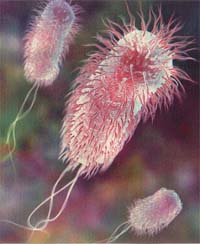Infectious Disease definition - Hemorrhagic Colitis

Hemorrhagic colitis
Hemorrhagic colitis is caused by gram negative rod, enterohemorrhagic escherichia coli.It require around 50 to 100 enterohemorrhagic e.coli to cause the infection.Enterohemorrhagic escherichia coli is sorbitol non fermenter. The common serotypes is based on the O and H antigen. The commonest strain which cause hemorrhagic colitis is e.coli strain 0157 H7.
The virulence mechanism of enterohemorrhagic colitis is shiga like toxin. Polymerase chain reaction and hybridization is useful in identifying the toxin genes. Enterohemorrhagic e.coli will adehere to the epithelial cell of the colon and secrete the toxin to the host cell. The shiga toxin will be carried by the lysogenized bacteriophage. Th shiga toxin may lead to death of cell and reduction in the synthesis of the protein due to the cleaves of the 28SRNA by the shiga toxin.
One of the complication of hemorrhagic colitis is the destruction of the glomerular endothelial cells which later results in hemolytic uremic syndrome and acute kidney failure. In this case antibiotic is avoided as it may worsen the condition and increase the susceptibiliy to develop hemolytic uremic syndrome Enterohemorrhagic e.coli will be transmitted through the ingestion of water and food which are contaminated.
Hemorrhagic colitis is treated by considering supportive and symptomatic treatment such as fluid and electrolytes replacement therapy.
References
1.Riley, Lee W. "The epidemiologic, clinical, and microbiologic features of hemorrhagic colitis." Annual Reviews in Microbiology 41.1 (1987): 383-405.
2.Neill, Marguerite A., Jan Agosti, and Henry Rosen. "Hemorrhagic colitis with Escherichia coli 0157: H7 preceding adult hemolytic uremic syndrome." Archives of internal medicine 145.12 (1985): 2215.
Hemorrhagic colitis is caused by gram negative rod, enterohemorrhagic escherichia coli.It require around 50 to 100 enterohemorrhagic e.coli to cause the infection.Enterohemorrhagic escherichia coli is sorbitol non fermenter. The common serotypes is based on the O and H antigen. The commonest strain which cause hemorrhagic colitis is e.coli strain 0157 H7.
The virulence mechanism of enterohemorrhagic colitis is shiga like toxin. Polymerase chain reaction and hybridization is useful in identifying the toxin genes. Enterohemorrhagic e.coli will adehere to the epithelial cell of the colon and secrete the toxin to the host cell. The shiga toxin will be carried by the lysogenized bacteriophage. Th shiga toxin may lead to death of cell and reduction in the synthesis of the protein due to the cleaves of the 28SRNA by the shiga toxin.
One of the complication of hemorrhagic colitis is the destruction of the glomerular endothelial cells which later results in hemolytic uremic syndrome and acute kidney failure. In this case antibiotic is avoided as it may worsen the condition and increase the susceptibiliy to develop hemolytic uremic syndrome Enterohemorrhagic e.coli will be transmitted through the ingestion of water and food which are contaminated.
Hemorrhagic colitis is treated by considering supportive and symptomatic treatment such as fluid and electrolytes replacement therapy.
References
1.Riley, Lee W. "The epidemiologic, clinical, and microbiologic features of hemorrhagic colitis." Annual Reviews in Microbiology 41.1 (1987): 383-405.
2.Neill, Marguerite A., Jan Agosti, and Henry Rosen. "Hemorrhagic colitis with Escherichia coli 0157: H7 preceding adult hemolytic uremic syndrome." Archives of internal medicine 145.12 (1985): 2215.
